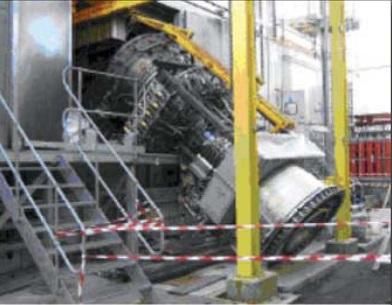WTUI conference 2015 highlights LM engines and GE aeroderivatives

Each year the Western Turbine Users Inc. (WTUI) conference takes place somewhere in the Western U.S. At the 2015 show, Long Beach, California welcomed over 1,200 attendees. As the event celebrated its 25th anniversary this year, it was appropriate that WTUI served up an abundance of history lessons.
“In the late 1980s, a handful of brave investors purchased some early model LM2500 and LM5000 gas turbines for service in California,” said WTUI President Chuck Casey, who is also Utility past Generation Manager at Riverside Public Utilities in California. “Their operation and maintenance personnel quickly realized the common issues and advantages of the LM engine, gathering in small groups to compare experiences and provide solutions to present to the OEM. Western Turbine Users was born.”
Initial presentations outlined the history of LM engines and highlights of earlier conferences. But it was the operations and maintenance (O&M) tips that most attendees craved. Three days of sessions delved into the intricate details of GE aeroderivatives.
Users gained insight on such areas as how to maintain an aging fleet, the primary factors in LM6000 outages, Selective Catalyst Reduction (SCR) best practices, HEPA filtration, Heat Recovery Steam Generators (HRSGs) and the latest on GE products. In addition, Mark Axford, President of Axford Consulting delivered his annual breakdown of trends and orders related to the gas turbine marketplace (p. 18).
Early days
The Western Turbine moniker is something of a misnomer, although it was initially begun in California and intended for aeroderivative turbine users from neighboring states. When an attempt to form an Eastern Turbine User Group failed, WTUI quickly encompassed all of the U.S. These days, users came from 42 states and far beyond. Of the 18 countries represented, Casey noted visitors from as far afield as Europe, Africa, Japan, Indonesia, Australia, and Central and South America.
Mike Raaker, WTUI’s historian and President of Raaker Services, gave an entertaining rundown of the organization’s tively began with a meeting between himself and three other operators of LM2500s. At that time, they were experiencing issues with failing starters, fuel nozzles and igniters. They needed to find a way to keep meeting availability and efficiency targets laid out in contracts that utilities were keen to break. Further anecdotes included various ups and down in the relationship between WTUI and the OEM. Happily, both sides now work closely together to make the conference a success.
Raaker was followed by Rick Kowalski, Vice President of Operations at Rick Kowalski MT R&O of Cincinnati, who talked about maintaining an aging fleet through part repairs. “LM engines maintain a strong track record although there is a finite availability of replacement parts in the market which has brought about an expressed need for salvage,” he said. “In the process of evaluating engine hardware found non-conforming to OEM specs, there is a requirement to consider ‘economic responsibility’ as part of the evaluation and disposition.”
His presentation covered the various options for repair such as joining, thermal sprays, plating, cleaning, coatings, shot peening and surface protections. Extending service life, he said, is a matter of applying the best and most substantiated technology on a per-component basis.
Kowalski stressed that users needed to respect the rights of ownership when it came to engine service decisions. He gave the example of a mid-fan shaft replacement for an LM6000. As such a part costs $230,000, the engine depot or service center should present the owner with all options and potential consequences. Perhaps a part does need to be replaced.
The final decision rests with the part/engine owner due to the investment involved. On the other side of the coin, an incorrect decision to attempt to salvage a faulty part could cause significant system and plant losses. Therefore, it is incumbent on the repair source or OEM who detects and evaluates the part condition to gather the facts, apply economic responsibility, present the recommendation and arm the owner with sufficient information to decide how best to proceed.
Material Review Board evaluators, said Kowalski, have five possible dispositions for components relating to service life. They can ‘use it as is’, they can ‘rework’ it and put it back the way it was, ‘repair’ the part to make it usable (though not back to the full spec), ‘reject’ the part (hold it for a possible repair development or substantiating evaluation for continued service at a later date) or ‘scrap’ it.
“You can’t take a single deviation on a small part as being okay unless you understand how it impacts associated parts or systems,” said Kowalski. “Scrapping a part is a disposition that can only be made by the owner unless he formally authorizes a representative to act on his behalf.”
While the ‘reject’ disposition is a temporary one, the ‘scrap’ disposition is permanent and requires the part to be physically destroyed to avoid its future use. He gave the example of a Stage 1 high pressure disk costing $623,000 where the owner was bypassed in the decision to replace the part. Other examples covered scrapped parts that should have been saved and repaired. His advice was for plants and engine owners to formalize the process of observation, evaluation and disposition.
“It’s not a game of making money on replacement parts, it’s a game of correctly making engines last longer,” said Kowalski. “OEMs, repair shops and users need to partner up to achieve this goal and be aware of economic responsibility.”
Please see May-June 2015 issue of Turbomachinery International magazine for more